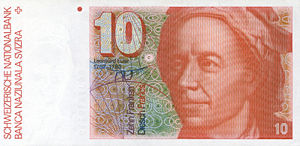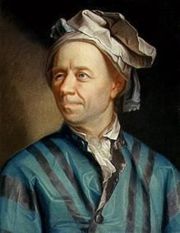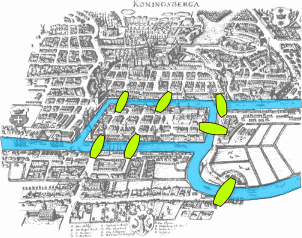Leonhard Euler
2008/9 Schools Wikipedia Selection. Related subjects: Mathematicians; Mathematics
| Leonhard Euler | |
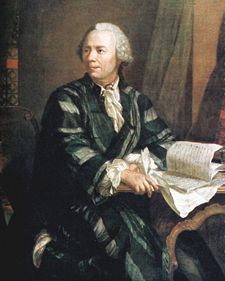 Portrait by Johann Georg Brucker
|
|
| Born | April 15, 1707 Basel, Switzerland |
|---|---|
| Died | September 18 [ O.S. September 7] 1783 St Petersburg, Russia |
| Residence | Prussia Russia Switzerland |
| Nationality | Swiss |
| Fields | Mathematician and physicist |
| Institutions | Imperial Russian Academy of Sciences Berlin Academy |
| Alma mater | University of Basel |
| Doctoral advisor | Johann Bernoulli |
| Doctoral students | Johann Hennert Joseph Lagrange |
| Known for | Euler's number |
| Religious stance | Calvinist |
| Signature |
|
Leonhard Paul Euler (pronounced IPA: [ˈœɪlɐ]; April 15, 1707 – September 18 [ O.S. September 7] 1783) was a pioneering Swiss mathematician and physicist, who spent most of his life in Russia and Germany.
Euler made important discoveries in fields as diverse as calculus and graph theory. He also introduced much of the modern mathematical terminology and notation, particularly for mathematical analysis, such as the notion of a mathematical function. He is also renowned for his work in mechanics, optics, and astronomy.
Euler is considered to be the preeminent mathematician of the 18th century and one of the greatest of all time. He is also one of the most prolific; his collected works fill 60–80 quarto volumes. A statement attributed to Pierre-Simon Laplace expresses Euler's influence on mathematics: "Read Euler, read Euler, he is the master [i.e., teacher] of us all."
Euler was featured on the sixth series of the Swiss 10-franc banknote and on numerous Swiss, German, and Russian postage stamps. The asteroid 2002 Euler was named in his honour. He is also commemorated by the Lutheran Church on their Calendar of Saints on May 24.
Biography
Early years
Euler was born in Basel to Paul Euler, a pastor of the Reformed Church, and Marguerite Brucker, a pastor's daughter. He had two younger sisters named Anna Maria and Maria Magdalena. Soon after the birth of Leonhard, the Eulers moved from Basel to the town of Riehen, where Euler spent most of his childhood. Paul Euler was a friend of the Bernoulli family— Johann Bernoulli, who was then regarded as Europe's foremost mathematician, would eventually be the most important influence on young Leonhard. Euler's early formal education started in Basel, where he was sent to live with his maternal grandmother. At the age of thirteen he matriculated at the University of Basel, and in 1723, received his M.Phil with a dissertation that compared the philosophies of Descartes and Newton. At this time, he was receiving Saturday afternoon lessons from Johann Bernoulli, who quickly discovered his new pupil's incredible talent for mathematics.
Euler was at this point studying theology, Greek, and Hebrew at his father's urging, in order to become a pastor. Johann Bernoulli intervened, and convinced Paul Euler that Leonhard was destined to become a great mathematician. In 1726, Euler completed his Ph.D. dissertation on the propagation of sound with the title De Sono and in 1727, he entered the Paris Academy Prize Problem competition, where the problem that year was to find the best way to place the masts on a ship. He won second place, losing only to Pierre Bouguer—who is now known as "the father of naval architecture". Euler subsequently won this coveted annual prize twelve times in his career.
St. Petersburg
Around this time Johann Bernoulli's two sons, Daniel and Nicolas, were working at the Imperial Russian Academy of Sciences in St Petersburg. In July 1726, Nicolas died of appendicitis after spending a year in Russia, and when Daniel assumed his brother's position in the mathematics/physics division, he recommended that the post in physiology that he had vacated be filled by his friend Euler. In November 1726 Euler eagerly accepted the offer, but delayed making the trip to St Petersburg while he unsuccessfully applied for a physics professorship at the University of Basel.
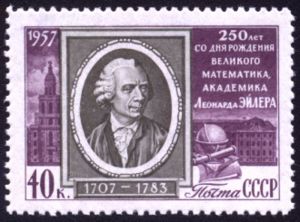
Euler arrived in the Russian capital on May 17, 1727. He was promoted from his junior post in the medical department of the academy to a position in the mathematics department. He lodged with Daniel Bernoulli with whom he often worked in close collaboration. Euler mastered Russian and settled into life in St Petersburg. He also took on an additional job as a medic in the Russian Navy.
The Academy at St. Petersburg, established by Peter the Great, was intended to improve education in Russia and to close the scientific gap with Western Europe. As a result, it was made especially attractive to foreign scholars like Euler. The academy possessed ample financial resources and a comprehensive library drawn from the private libraries of Peter himself and of the nobility. Very few students were enrolled in the academy so as to lessen the faculty's teaching burden, and the academy emphasized research and offered to its faculty both the time and the freedom to pursue scientific questions.
The Academy's benefactress, Catherine I, who had continued the progressive policies of her late husband, died on the day of Euler's arrival. The Russian nobility then gained power upon the ascension of the twelve-year-old Peter II. The nobility were suspicious of the academy's foreign scientists, and thus cut funding and caused other difficulties for Euler and his colleagues.
Conditions improved slightly upon the death of Peter II, and Euler swiftly rose through the ranks in the academy and was made professor of physics in 1731. Two years later, Daniel Bernoulli, who was fed up with the censorship and hostility he faced at St. Petersburg, left for Basel. Euler succeeded him as the head of the mathematics department.
On January 7, 1734, he married Katharina Gsell, daughter of a painter from the Academy Gymnasium. The young couple bought a house by the Neva River. Of their thirteen children, only five survived childhood.
Berlin
Concerned about the continuing turmoil in Russia, Euler left St. Petersburg on June 19, 1741 to take up a post at the Berlin Academy, which he had been offered by Frederick the Great of Prussia. He lived for twenty-five years in Berlin, where he wrote over 380 articles. In Berlin, he published the two works which he would be most renowned for: the Introductio in analysin infinitorum, a text on functions published in 1748, and the Institutiones calculi differentialis, published in 1755 on differential calculus.
In addition, Euler was asked to tutor the Princess of Anhalt-Dessau, Frederick's niece. Euler wrote over 200 letters to her, which were later compiled into a best-selling volume entitled Letters of Euler on different Subjects in Natural Philosophy Addressed to a German Princess. This work contained Euler's exposition on various subjects pertaining to physics and mathematics, as well as offering valuable insights into Euler's personality and religious beliefs. This book became more widely read than any of his mathematical works, and it was published across Europe and in the United States. The popularity of the 'Letters' testifies to Euler's ability to communicate scientific matters effectively to a lay audience, a rare ability for a dedicated research scientist.
Despite Euler's immense contribution to the Academy's prestige, he was eventually forced to leave Berlin. This was partly because of a conflict of personality with Frederick, who came to regard Euler as unsophisticated, especially in comparison to the circle of philosophers the German king brought to the Academy. Voltaire was among those in Frederick's employ, and the Frenchman enjoyed a prominent position in the king's social circle. Euler, a simple religious man and a hard worker, was very conventional in his beliefs and tastes. He was in many ways the direct opposite of Voltaire. Euler had limited training in rhetoric, and tended to debate matters that he knew little about, making him a frequent target of Voltaire's wit. Frederick also expressed disappointment with Euler's practical engineering abilities:
| “ | I wanted to have a water jet in my garden: Euler calculated the force of the wheels necessary to raise the water to a reservoir, from where it should fall back through channels, finally spurting out in Sanssouci. My mill was carried out geometrically and could not raise a mouthful of water closer than fifty paces to the reservoir. Vanity of vanities! Vanity of geometry! | ” |
Eyesight deterioration
Euler's eyesight worsened throughout his mathematical career. Three years after suffering a near-fatal fever in 1735 he became nearly blind in his right eye, but Euler rather blamed his condition on the painstaking work on cartography he performed for the St. Petersburg Academy. Euler's sight in that eye worsened throughout his stay in Germany, so much so that Frederick referred to him as "Cyclops". Euler later suffered a cataract in his good left eye, rendering him almost totally blind a few weeks after its discovery. Even so, his condition appeared to have little effect on his productivity, as he compensated for it with his mental calculation skills and photographic memory. For example, Euler could repeat the Aeneid of Virgil from beginning to end without hesitation, and for every page in the edition he could indicate which line was the first and which the last.
Return to Russia
The situation in Russia had improved greatly since the ascension of Catherine the Great, and in 1766 Euler accepted an invitation to return to the St. Petersburg Academy and spent the rest of his life in Russia. His second stay in the country was marred by tragedy. A fire in St. Petersburg in 1771 cost him his home, and almost his life. In 1773, he lost his wife of 40 years. Euler remarried three years later.
On September 18, 1783, Euler passed away in St. Petersburg after suffering a brain hemorrhage, and was buried with his wife in the Smolensk Lutheran Cemetery on Vasilievsky Island (the Soviets destroyed the cemetery after transferring Euler's remains to the Orthodox Alexander Nevsky Lavra). His eulogy was written for the French Academy by the French mathematician and philosopher Marquis de Condorcet, and an account of his life, with a list of his works, by Nikolaus von Fuss, Euler's son-in-law and the secretary of the Imperial Academy of St. Petersburg. Condorcet commented,
| “ | …il cessa de calculer et de vivre — … he ceased to calculate and to live. | ” |
Contributions to mathematics
Euler worked in almost all areas of mathematics: geometry, calculus, trigonometry, algebra, and number theory, as well as continuum physics, lunar theory and other areas of physics. He is a seminal figure in the history of mathematics; if printed, his works, many of which are of fundamental interest, would occupy between 60 and 80 quarto volumes. Euler's name is associated with a large number of topics. Among mathematicians, perhaps only the 20th century Hungarian Paul Erdős was comparably prolific.
Mathematical notation
Euler introduced and popularized several notational conventions through his numerous and widely circulated textbooks. Most notably, he introduced the concept of a function and was the first to write f(x) to denote the function f applied to the argument x. He also introduced the modern notation for the trigonometric functions, the letter e for the base of the natural logarithm (now also known as Euler's number), the Greek letter Σ for summations and the letter i to denote the imaginary unit. The use of the Greek letter π to denote the ratio of a circle's circumference to its diameter was also popularized by Euler, although it did not originate with him.
Analysis
The development of calculus was at the forefront of 18th century mathematical research, and the Bernoullis—family friends of Euler—were responsible for much of the early progress in the field. Thanks to their influence, studying calculus became the major focus of Euler's work. While some of Euler's proofs are not acceptable by modern standards of mathematical rigour, his ideas led to many great advances.
He is well known in analysis for his frequent use and development of power series: that is, the expression of functions as sums of infinitely many terms, such as
Notably, Euler discovered the power series expansions for e and the inverse tangent function. His daring (and, by modern standards, technically incorrect) use of power series enabled him to solve the famous Basel problem in 1735:
Euler introduced the use of the exponential function and logarithms in analytic proofs. He discovered ways to express various logarithmic functions using power series, and he successfully defined logarithms for negative and complex numbers, thus greatly expanding the scope of mathematical applications of logarithms. He also defined the exponential function for complex numbers, and discovered its relation to the trigonometric functions. For any real number φ, Euler's formula states that the complex exponential function satisfies
A special case of the above formula is known as Euler's identity,
called "the most remarkable formula in mathematics" by Richard Feynman, for its single uses of the notions of addition, multiplication, exponentiation, and equality, and the single uses of the important constants 0, 1, e, i and π. In 1988, the readers of the Mathematical Intelligencer voted it "the Most Beautiful Mathematical Formula Ever". In total, Euler was responsible for three of the top five formulae in that poll.
In addition, Euler elaborated the theory of higher transcendental functions by introducing the gamma function and introduced a new method for solving quartic equations. He also found a way to calculate integrals with complex limits, foreshadowing the development of modern complex analysis, and invented the calculus of variations including its best-known result, the Euler-Lagrange equation.
Euler also pioneered the use of analytic methods to solve number theory problems. In doing so, he united two disparate branches of mathematics and introduced a new field of study, analytic number theory. In breaking ground for this new field, Euler created the theory of hypergeometric series, q-series, hyperbolic trigonometric functions and the analytic theory of continued fractions. For example, he proved the infinitude of primes using the divergence of the harmonic series, and he used analytic methods to gain some understanding of the way prime numbers are distributed. Euler's work in this area led to the development of the prime number theorem.
Number theory
Euler's interest in number theory can be traced to the influence of Christian Goldbach, his friend in the St. Petersburg Academy. A lot of Euler's early work on number theory was based on the works of Pierre de Fermat. Euler developed some of Fermat's ideas, and disproved some of his conjectures.
Euler linked the nature of prime distribution with ideas in analysis. He proved that the sum of the reciprocals of the primes diverges. In doing so, he discovered the connection between the Riemann zeta function and the prime numbers; this is known as the Euler product formula for the Riemann zeta function.
Euler proved Newton's identities, Fermat's little theorem, Fermat's theorem on sums of two squares, and he made distinct contributions to Lagrange's four-square theorem. He also invented the totient function φ(n) which is the number of positive integers less than the integer n that are coprime to n. Using properties of this function, he generalized Fermat's little theorem to what is now known as Euler's theorem. He contributed significantly to the understanding of perfect numbers, which has fascinated mathematicians since Euclid. Euler also made progress toward the prime number theorem, and he conjectured the law of quadratic reciprocity. The two concepts are regarded as fundamental theorems of number theory, and his ideas paved the way for the work of Carl Friedrich Gauss.
By 1772 Euler had proved that 231 - 1 = 2,147,483,647 is a Mersenne prime. It may have remained the largest known prime until 1867.
Graph theory
In 1736, Euler solved the problem known as the Seven Bridges of Königsberg. The city of Königsberg, Prussia was set on the Pregel River, and included two large islands which were connected to each other and the mainland by seven bridges. The problem is to decide whether it is possible to follow a path that crosses each bridge exactly once and returns to the starting point. It is not: there is no Eulerian circuit. This solution is considered to be the first theorem of graph theory and planar graph theory. Euler also introduced the notion now known as the Euler characteristic of a space and a formula relating the number of edges, vertices, and faces of a convex polyhedron with this constant. The study and generalization of this formula, specifically by Cauchy and L'Huillier, is at the origin of topology.
Applied mathematics
Some of Euler's greatest successes were in solving real-world problems analytically, and in describing numerous applications of Bernoulli's numbers, Fourier series, Venn diagrams, Euler numbers, the constants e and π, continued fractions and integrals. He integrated Leibniz's differential calculus with Newton's Method of Fluxions, and developed tools that made it easier to apply calculus to physical problems. He made great strides in improving the numerical approximation of integrals, inventing what are now known as the Euler approximations. The most notable of these approximations are Euler's method and the Euler-Maclaurin formula. He also facilitated the use of differential equations, in particular introducing the Euler-Mascheroni constant:
One of Euler's more unusual interests was the application of mathematical ideas in music. In 1739 he wrote the Tentamen novae theoriae musicae, hoping to eventually incorporate musical theory as part of mathematics. This part of his work, however, did not receive wide attention and was once described as too mathematical for musicians and too musical for mathematicians.
Physics and astronomy
Euler helped develop the Euler-Bernoulli beam equation, which became a cornerstone of engineering. Aside from successfully applying his analytic tools to problems in classical mechanics, Euler also applied these techniques to celestial problems. His work in astronomy was recognized by a number of Paris Academy Prizes over the course of his career. His accomplishments include determining with great accuracy the orbits of comets and other celestial bodies, understanding the nature of comets, and calculating the parallax of the sun. His calculations also contributed to the development of accurate longitude tables.
In addition, Euler made important contributions in optics. He disagreed with Newton's corpuscular theory of light in the Opticks, which was then the prevailing theory. His 1740s papers on optics helped ensure that the wave theory of light proposed by Christian Huygens would become the dominant mode of thought, at least until the development of the quantum theory of light.
Logic
He is also credited with using closed curves to illustrate syllogistic reasoning (1768). These diagrams have become known as Euler diagrams.
Personal philosophy and religious beliefs
Euler and his friend Daniel Bernoulli were opponents of Leibniz's monism and the philosophy of Christian Wolff. Euler insisted that knowledge is founded in part on the basis of precise quantitative laws, something that monadism and Wolffian science were unable to provide. Euler's religious leanings might also have had a bearing on his dislike of the doctrine; he went so far as to label Wolff's ideas as "heathen and atheistic".
Much of what is known of Euler's religious beliefs can be deduced from his Letters to a German Princess and an earlier work, Rettung der Göttlichen Offenbahrung Gegen die Einwürfe der Freygeister (Defense of the Divine Revelation against the Objections of the Freethinkers). These works present Euler as a staunch Christian and a biblical literalist (for example, the Rettung was primarily an argument for the divine inspiration of scripture).
There is a famous anecdote inspired by Euler's arguments with secular philosophers over religion, which is set during Euler's second stint at the St. Petersburg academy. The French philosopher Denis Diderot was visiting Russia on Catherine the Great's invitation. However, the Empress was alarmed that the philosopher's arguments for atheism were influencing members of her court, and so Euler was asked to confront the Frenchman. Diderot was later informed that a learned mathematician had produced a proof of the existence of God: he agreed to view the proof as it was presented in court. Euler appeared, advanced toward Diderot, and in a tone of perfect conviction announced, "Sir,  , hence God exists—reply!". Diderot, to whom (says the story) all mathematics was gibberish, stood dumbstruck as peals of laughter erupted from the court. Embarrassed, he asked to leave Russia, a request that was graciously granted by the Empress. However amusing the anecdote may be, it is almost certainly apocryphal, given that Diderot was a capable mathematician who had published mathematical treatises.
, hence God exists—reply!". Diderot, to whom (says the story) all mathematics was gibberish, stood dumbstruck as peals of laughter erupted from the court. Embarrassed, he asked to leave Russia, a request that was graciously granted by the Empress. However amusing the anecdote may be, it is almost certainly apocryphal, given that Diderot was a capable mathematician who had published mathematical treatises.
